Integral to process control in many industries, level sensors fall into two main types. Point level measurement sensors
are used to mark a single discrete liquid height–a preset level condition. Generally, this type of sensor functions as a high alarm,
signaling an overfill condition, or as a marker for a low alarm condition. Continuous level transmitters are more sophisticated and can
provide level monitoring of an entire system. They measure fluid level within a range, rather than at a one point, producing an analog
output that directly correlates to the liquid level in the vessel. To create a level management system, the output signal is linked to a
process control loop and to a visual indicator.
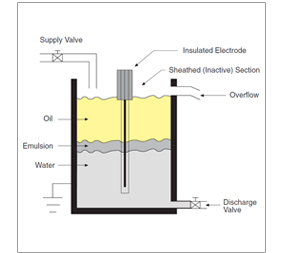
Level Interface Detection
What is a level Switch?
In these point level sensors, a magnetic float moves with the liquid surface, actuating a hermetically sealed "reed switch"
in the stem. The simple, low-maintenance design installs readily; minimizes shock, vibration, and pressure; and works with a
variety of media. The reed switch can be single pole, single throw (SPST) or single pole, double throw (SPDT).
Non-Contact Ultrasonic Sensors for liquid level Measurement
These transmitters incorporate an analog signal processor, a microprocessor, binary coded decimal (BCD) range switches, and an output
driver circuit. Transmit pulses and a gate signal from the microprocessor route through the analog signal processor to the sensor,
which sends an ultrasonic beam to the liquid surface. The sensor detects the echo from the surface and routes it back to the microprocessor
for a digital representation of the distance between the sensor and the liquid level. Through constant updating of received signals,
the microprocessor calculates averaged values to measure liquid level.
With a continuous sensor, the microprocessor converts the averaged value to an analog 4 to 20 mA signal linear with the liquid level.
When the echo from the level does not return to the sensor within 8 seconds, the output signal from the system drops below 4 mA,
indicating a low-level condition or empty pipe. With a point sensor, the microprocessor compares the averaged value with the BCD switch
setting and energizes an output relay for either high or low level indication. A signal loss exceeding 8 seconds de-energizes the relays
and restores their original state. The electronics incorporate a half-second delay that minimizes surface turbulence effects.
Contact Ultrasonic Sensors for Level Measurement Applications
A low-energy ultrasonic device within these sensors measures liquid level at a certain point. Consisting of a field-mounted sensor and
integral solid state amplifier, contact ultrasonic sensors have no moving parts and require no calibration. Typically, they are equipped
with terminal blocks for connection of a power source and external control devices. The ultrasonic signal crosses a one-half inch gap in
the sensor, controlling relay switches when the gap contains liquid. The sensing level is midway along the gap for horizontally mounted
sensors, at the top of the gap for vertically mounted sensors. As liquid falls below this level, the ultrasonic signal attenuates and
ultimately switches the relay to its prior state.
These level sensors are used in vessels or pipes to automatically operate pumps, solenoid valves, and high/low alarms. Two would be required to
fill and empty tanks, and to meter liquid volumes. Compatible with most liquids, they are unaffected by coatings, clinging droplets, foam,
and vapor. However, highly aerated liquids and liquids viscous enough to clog the sensor gap may cause problems.
Capacitance Level transmitters
Like ultrasonic sensors, capacitance sensors can handle point or continuous level measurement. They use a probe to monitor liquid level
changes in the tank, electronically conditioning the output to capacitive and resistive values, which are converted to analog signals.
The probe and the vessel wall equate to two plates of a capacitor, the liquid to the dielectric medium. Because the signal emanates
from level changes alone, material build-up on the probe has no effect. Non-conductive fluid vessels may dictate dual probes or an
external conducting strip.
The probe, which can be rigid or flexible, commonly employs conducting wire insulated with PTFE. Using stainless steel as the probe's
base metal provides the extra sensitivity needed for measuring liquids that are non-conductive, granular, or low in dielectric properties
(dielectric constant less than 4). Flexible probes must be used when there is insufficient clearance for a rigid probe, or in applications
that demand very long lengths. Rigid probes offer higher stability, especially in turbulent systems, where swaying of the probe can
cause signal fluctuations.
 CLOSE
CLOSE



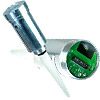
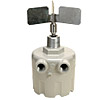
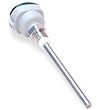
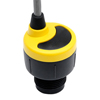
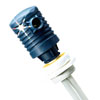

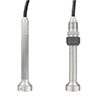
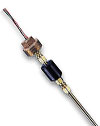
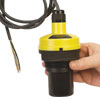

 Medição de Nível
Medição de Nível Mesure de Niveau
Mesure de Niveau Medición de Nivel
Medición de Nivel Medición de Nivel
Medición de Nivel Level Measurement
Level Measurement Niveaumåling
Niveaumåling  Mesure et Détection de Niveau
Mesure et Détection de Niveau Füllstandmessung
Füllstandmessung Indicatori e misuratori di livello
Indicatori e misuratori di livello Level Measurement
Level Measurement Sensores de Nivel y Medición
Sensores de Nivel y Medición Level Measurement
Level Measurement Level Measurement
Level Measurement Level Measurement
Level Measurement
 レベル測定
レベル測定 레벨센서
레벨센서 Level Measurement
Level Measurement
 Level Measurement
Level Measurement
 Level Measurement
Level Measurement
 Level Measurement
Level Measurement
 Level Measurement
Level Measurement